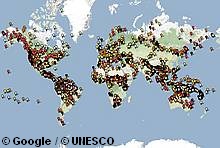
In 2010, UNESCO (United Nations Educational, Scientific and Cultural Organization) launched a free Interactive Atlas of the World’s Languages in Danger.
The online edition is a complement of the print edition (3rd edition, 2010), edited by Christopher Moseley, and available in English, French and Spanish, with previous editions in 1996 and 2001.
2,473 languages were listed on 25 July 2011, with a search engine by country and area, language name, number of speakers from/to, vitality and ISO 639-3 code.
The language names have been indicated in English, French and Spanish transcriptions. Alternate names (spelling variants, dialects or names in non-Roman scripts) are also provided.
About language vitality
UNESCO’s Language Vitality and Endangerement framework has established six degrees of vitality/endangerement: safe, vulnerable, definitely endangered, severely endangered, critically endangered, extinct.
“Safe” – not included in the atlas – means that the language is spoken by all generations and that intergenerational transmission is uninterrupted.
“Vulnerable” means that most children speak the language, but it may be restricted to certain domains, for example at home.
“Definitely endangered” means that children no longer learn the language as a mother tongue in the home.
“Severely endangered” means that the language is spoken by grand-parents and older generations. While the parent generation may understand it, they don’t speak it to children or among themselves.
“Critically endangered” means that the youngest speakers are grandparents and older, and they speak the language partially and infrequently.
“Extinct” means there are no speakers left. The atlas includes presumably extinct languages since the 1950s.
How to define an endangered language
When exactly is a language considered as endangered? As explained by UNESCO on the interactive altas’ website: “A language is endangered when its speakers cease to use it, use it in fewer and fewer domains, use fewer of its registers and speaking styles, and/or stop passing it on to the next generation. No single factor determines whether a language is endangered.”
UNESCO experts have identified nine factors that should be considered together: (a) intergenerational language transmission; (b) absolute number of speakers; (c) proportion of speakers within the total population; (d) shifts in domains of language use; (e) response to new domains and media; (f) availability of materials for language education and literacy; (g) governmental and institutional language attitudes and policies including official status and use; (h) community members’ attitudes towards their own language; (i) amount and quality of documentation.
What are the causes of language endangerement and disappearance? “A language disappears when its speakers disappear or when they shift to speaking another language — most often, a larger language used by a more powerful group. Languages are threatened by external forces such as military, economic, religious, cultural or educational subjugation, or by internal forces such as a community’s negative attitude towards its own language. Today, increased migration and rapid urbanization often bring along the loss of traditional ways of life and a strong pressure to speak a dominant language that is — or is perceived to be — necessary for full civic participation and economic advancement.”
Copyright © 2011 Marie Lebert
ToC :: Next article: eBooks: 2011 – The ebook in ten points